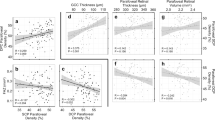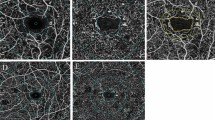Abstract
Purpose
To investigate the prognostic value of peripheral retinal nonperfusion in patients with diabetic retinopathy using ultra-widefield fluorescein angiography (UWFA).
Methods
A cross-sectional study included 78 treatment-naïve eyes with nonproliferative and proliferative diabetic retinopathy (NPDR and PDR). Eyes were divided into three groups: mild/moderate NPDR (n = 31), severe NPDR (n = 31), and PDR (n = 16). Three nonperfusion variables were calculated reflecting the proportion of nonperfused to visible retina based on initial UWFA: central nonperfusion (CNP) index, peripheral nonperfusion (PNP) index, and PNP ratio. The relationships between these indices and central subfield thickness (CST) and spectacle-corrected visual acuity (SCVA) were evaluated.
Results
CNP and PNP indices were significantly higher in the PDR group vs. mild/moderate NPDR group (p = 0.007 and 0.008, respectively) but not in the PDR group vs. severe NPDR group (p = 0.149 and p = 0.535, respectively). A significant linear correlation was found between the CNP and PNP indices in both severe NPDR and PDR groups (R2 = 0.141, p = 0.041, and R2 = 0.311, p = 0.025, respectively). Nonperfusion predominance was not statistically correlated with the presence of macular edema (p = 0.058) or disorganization of retinal inner layers (p = 1). In the severe NPDR group, there was a moderately positive correlation between CNP index and CST (rs = 0.496, p = 0.019) and no correlation between CNP index and SCVA when controlling for CST (p = 0.160). In the PDR group, a strong negative correlation between PNP ratio and CST was found (rs = −0.659, p = 0.014), but no correlation was observed between CNP index, CST, and SCVA. In the PDR group, a positive correlation was found between PNP index, PNP ratio, and SCVA (rs = 0.549, p = 0.027, and rs = 0.626, p = 0.010, respectively), even after controlling for CST (rs = 0.599, p = 0.040).
Conclusions
Higher amounts of retinal nonperfusion are seen in patients with more severe retinopathy. Increased CNP is associated with macular thickening and subsequent vision loss. Having predominantly PNP was independently associated with worse VA, regardless of macular thickness. Further studies are needed to investigate the role of PNP in vision loss in diabetic retinopathy.


Similar content being viewed by others
References
Antonetti DA, Klein R, Gardner TW (2012) Diabetic retinopathy. N Engl J Med 366(13):1227–1239. https://doi.org/10.1056/NEJMra1005073
Duh EJ, Sun JK, Stitt AW (2017) Diabetic retinopathy: current understanding, mechanisms, and treatment strategies. JCI Insight 2(14). https://doi.org/10.1172/jci.insight.93751
Diabetes C, Complications Trial Research G, Nathan DM, Genuth S, Lachin J, Cleary P, Crofford O, Davis M, Rand L, Siebert C (1993) The effect of intensive treatment of diabetes on the development and progression of long-term complications in insulin-dependent diabetes mellitus. N Engl J Med 329(14):977–986. https://doi.org/10.1056/NEJM199309303291401
Effect of intensive blood-glucose control with metformin on complications in overweight patients with type 2 diabetes (UKPDS 34). UK Prospective Diabetes Study (UKPDS) Group (1998). Lancet 352 (9131):854–865
Yau JW, Rogers SL, Kawasaki R, Lamoureux EL, Kowalski JW, Bek T, Chen SJ, Dekker JM, Fletcher A, Grauslund J, Haffner S, Hamman RF, Ikram MK, Kayama T, Klein BE, Klein R, Krishnaiah S, Mayurasakorn K, O'Hare JP, Orchard TJ, Porta M, Rema M, Roy MS, Sharma T, Shaw J, Taylor H, Tielsch JM, Varma R, Wang JJ, Wang N, West S, Xu L, Yasuda M, Zhang X, Mitchell P, Wong TY, Meta-Analysis for Eye Disease Study G (2012) Global prevalence and major risk factors of diabetic retinopathy. Diabetes Care 35 (3):556–564. doi:https://doi.org/10.2337/dc11-1909
Grading diabetic retinopathy from stereoscopic color fundus photographs--an extension of the modified Airlie House classification. ETDRS report number 10. Early Treatment Diabetic Retinopathy Study Research Group (1991). Ophthalmology 98 (5 Suppl):786–806
Kaines A, Oliver S, Reddy S, Schwartz SD (2009) Ultrawide angle angiography for the detection and management of diabetic retinopathy. Int Ophthalmol Clin 49(2):53–59. https://doi.org/10.1097/IIO.0b013e31819fd471
Silva PS, Cavallerano JD, Sun JK, Soliman AZ, Aiello LM, Aiello LP (2013) Peripheral lesions identified by mydriatic ultrawide field imaging: distribution and potential impact on diabetic retinopathy severity. Ophthalmology 120(12):2587–2595. https://doi.org/10.1016/j.ophtha.2013.05.004
Baxter SL, Ashir A, Nguyen BJ, Nudleman E (2019) Quantification of retinal nonperfusion associated with posterior segment neovascularization in diabetic retinopathy using ultra-Widefield fluorescein angiography. Ophthalmic Surg Lasers Imaging Retina 50(2):86–92. https://doi.org/10.3928/23258160-20190129-04
Sim DA, Keane PA, Rajendram R, Karampelas M, Selvam S, Powner MB, Fruttiger M, Tufail A, Egan CA (2014) Patterns of peripheral retinal and central macula ischemia in diabetic retinopathy as evaluated by ultra-widefield fluorescein angiography. Am J Ophthalmol 158(1):144–153 e141. https://doi.org/10.1016/j.ajo.2014.03.009
Nicholson L, Ramu J, Chan EW, Bainbridge JW, Hykin PG, Talks SJ, Sivaprasad S (2019) Retinal nonperfusion characteristics on ultra-widefield angiography in eyes with severe nonproliferative diabetic retinopathy and proliferative diabetic retinopathy. JAMA Ophthalmol 137(6):626–631. https://doi.org/10.1001/jamaophthalmol.2019.0440
Sim DA, Keane PA, Zarranz-Ventura J, Fung S, Powner MB, Platteau E, Bunce CV, Fruttiger M, Patel PJ, Tufail A, Egan CA (2013) The effects of macular ischemia on visual acuity in diabetic retinopathy. Invest Ophthalmol Vis Sci 54(3):2353–2360. https://doi.org/10.1167/iovs.12-11103
Fang M, Fan W, Shi Y, Ip MS, Wykoff CC, Wang K, Falavarjani KG, Brown DM, van Hemert J, Sadda SR (2019) Classification of regions of nonperfusion on ultra-widefield fluorescein angiography in patients with diabetic macular edema. Am J Ophthalmol. https://doi.org/10.1016/j.ajo.2019.03.030
Wessel MM, Nair N, Aaker GD, Ehrlich JR, D'Amico DJ, Kiss S (2012) Peripheral retinal ischaemia, as evaluated by ultra-widefield fluorescein angiography, is associated with diabetic macular oedema. Br J Ophthalmol 96(5):694–698. https://doi.org/10.1136/bjophthalmol-2011-300774
Holladay JT (2004) Visual acuity measurements. J Cataract Refract Surg 30(2):287–290. https://doi.org/10.1016/j.jcrs.2004.01.014
Sun JK, Lin MM, Lammer J, Prager S, Sarangi R, Silva PS, Aiello LP (2014) Disorganization of the retinal inner layers as a predictor of visual acuity in eyes with center-involved diabetic macular edema. JAMA Ophthalmol 132(11):1309–1316. https://doi.org/10.1001/jamaophthalmol.2014.2350
Quigley M, Cohen S (1999) A new pressure attenuation index to evaluate retinal circulation. A link to protective factors in diabetic retinopathy. Arch Ophthalmol 117(1):84–89. https://doi.org/10.1001/archopht.117.1.84
Wang W, Lo ACY (2018) Diabetic retinopathy: pathophysiology and treatments. Int J Mol Sci 19(6). https://doi.org/10.3390/ijms19061816
Adamis AP, Miller JW, Bernal MT, D'Amico DJ, Folkman J, Yeo TK, Yeo KT (1994) Increased vascular endothelial growth factor levels in the vitreous of eyes with proliferative diabetic retinopathy. Am J Ophthalmol 118(4):445–450. https://doi.org/10.1016/s0002-9394(14)75794-0
Virgili G, Parravano M, Evans JR, Gordon I, Lucenteforte E (2018) Anti-vascular endothelial growth factor for diabetic macular oedema: a network meta-analysis. Cochrane Database Syst Rev 10:CD007419. https://doi.org/10.1002/14651858.CD007419.pub6
Nussenblatt RB, Kaufman SC, Palestine AG, Davis MD, Ferris FL 3rd (1987) Macular thickening and visual acuity. Measurement in patients with cystoid macular edema. Ophthalmology 94(9):1134–1139. https://doi.org/10.1016/s0161-6420(87)33314-7
Rangaraju L, Jiang X, McAnany JJ, Tan MR, Wanek J, Blair NP, Lim JI, Shahidi M (2018) Association between visual acuity and retinal layer metrics in diabetics with and without macular edema. J Ophthalmol 2018:1089043. https://doi.org/10.1155/2018/1089043
Radwan SH, Soliman AZ, Tokarev J, Zhang L, van Kuijk FJ, Koozekanani DD (2015) Association of disorganization of retinal inner layers with vision after resolution of center-involved diabetic macular edema. JAMA Ophthalmol 133(7):820–825. https://doi.org/10.1001/jamaophthalmol.2015.0972
Balaratnasingam C, Inoue M, Ahn S, McCann J, Dhrami-Gavazi E, Yannuzzi LA, Freund KB (2016) Visual acuity is correlated with the area of the Foveal avascular zone in diabetic retinopathy and retinal vein occlusion. Ophthalmology 123(11):2352–2367. https://doi.org/10.1016/j.ophtha.2016.07.008
Das R, Spence G, Hogg RE, Stevenson M, Chakravarthy U (2018) Disorganization of inner retina and outer retinal morphology in diabetic macular edema. JAMA Ophthalmol 136(2):202–208. https://doi.org/10.1001/jamaophthalmol.2017.6256
Nicholson L, Ramu J, Triantafyllopoulou I, Patrao NV, Comyn O, Hykin P, Sivaprasad S (2015) Diagnostic accuracy of disorganization of the retinal inner layers in detecting macular capillary non-perfusion in diabetic retinopathy. Clin Exp Ophthalmol 43(8):735–741. https://doi.org/10.1111/ceo.12557
Sawada O, Ichiyama Y, Obata S, Ito Y, Kakinoki M, Sawada T, Saishin Y, Ohji M (2018) Comparison between wide-angle OCT angiography and ultra-wide field fluorescein angiography for detecting non-perfusion areas and retinal neovascularization in eyes with diabetic retinopathy. Graefes Arch Clin Exp Ophthalmol 256(7):1275–1280. https://doi.org/10.1007/s00417-018-3992-y
Couturier A, Rey PA, Erginay A, Lavia C, Bonnin S, Dupas B, Gaudric A, Tadayoni R (2019) Widefield OCT-angiography and fluorescein angiography assessments of nonperfusion in diabetic retinopathy and edema treated with anti-vascular endothelial growth factor. Ophthalmology 126(12):1685–1694. https://doi.org/10.1016/j.ophtha.2019.06.022
Funding
No funding was received for this research.
Author information
Authors and Affiliations
Corresponding author
Ethics declarations
Conflict of interest
F. Antaki declares that he has no conflict of interest in relation to this research; R.G. Coussa declares that he has no conflict of interest in relation to this research; M. Mikhail declares that he has no conflict of interest in relation to this research; C. Archambault declares that he has no conflict of interest in relation to this research; D.E. Lederer declares that he has no conflict of interest in relation to this research.
Ethical approval
All procedures performed in studies involving human participants were in accordance with the ethical standards of the institutional and/or national research committee and with the 1964 Helsinki declaration and its later amendments or comparable ethical standards.
Informed consent
Informed consent was waived because of the retrospective design of the study.
Additional information
Publisher’s note
Springer Nature remains neutral with regard to jurisdictional claims in published maps and institutional affiliations.
Rights and permissions
About this article
Cite this article
Antaki, F., Coussa, R.G., Mikhail, M. et al. The prognostic value of peripheral retinal nonperfusion in diabetic retinopathy using ultra-widefield fluorescein angiography. Graefes Arch Clin Exp Ophthalmol 258, 2681–2690 (2020). https://doi.org/10.1007/s00417-020-04847-w
Received:
Revised:
Accepted:
Published:
Issue Date:
DOI: https://doi.org/10.1007/s00417-020-04847-w




